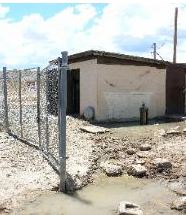Public Water Systems and Their Categories
Community Water Systems (CWS) a public water system which serves at least 15 service
connections used by year-round residents or regularly serves at least 25 year-round residents.
Non-Transient, Non-Community Water Systems (NTNCWS) a public water systems that is not a
“community water system” and that regularly serves at least 25 of the same persons for more than 6
months per year, including but not limited to schools, factories and public buildings.
Transient, Non-Community Water Systems (TNCWS) a public water systems that is neither a
“community water system” nor a “non-transient non-community water system,” including but not
limited to seasonal facilities such as children’s camps or recreational camping areas; and year-
round facilities that serve more than 25 persons who are not residents thereof, such as gasoline
service stations, marinas, rest areas and restaurants that are not served by a community water
system. These systems are required to sample bacteriological quality on a quarterly basis and for
nitrate/nitrite annually.
Consecutive Public Water Systems a public water systems that purchase water from a primary
purveyor. This type of water system typically purchases water, pumps the water into their own storage
tanks and distributes the water through their own pipes (i.e., schools, stores, etc.) These systems are
required to monitor for bacteriological quality on a monthly basis, lead/copper, and asbestos (if
asbestos-cement (AC) pipe is used in the distribution).
Sanitary Survey Inspections
PWSSP conducts 75-80 on-site sanitary survey inspections per year depending on condition of the water PWSSP conducts inspections of all public water systems under the jurisdiction of the Navajo Nation. These inspections are conducted to evaluate the adequacy of the source, facilities, equipment, operation and maintenance for producing and distributing safe drinking water.


Follow-up Inspections
Follow-up inspections are conducted from 6 months to a year depending on the condition of the PWS and
their compliance status. Groundwater inspections are conducted on a 2-5 year basis depending on the
condition of the PWS. Surface water and Groundwater Under the Direct Influence (GWUDI) of Surface Water
inspections are conducted on an annual basis.
Enforcement Inspections
Enforcement inspections are conducted by U.S. EPA, Region IX or they contract consultants to conduct these
special inspections on systems that Navajo PWSSP has no jurisdiction to regulate the water system.
Abandoned Wells
Many abandoned wells are frequently found
during scheduled water inspections. The
PWSSP is currently working with the
Department of Water Resources to ensure
the proper abandonment of these types of
wells. In the interim, PWSSP recommends
that these wells be welded with a metal cap.
These types of wells posed a threat to the
overall quality of an aquifer. These wells
are not typically covered or protected from
any potential threat of contamination.
Enforcement Inspections
Enforcement inspections are conducted by U.S. EPA, Region IX or they contract consultants to conduct these
special inspections on systems that Navajo PWSSP has no jurisdiction to regulate the water system.
Abandoned Wells


Many abandoned wells are frequently found
during scheduled water inspections. The
PWSSP is currently working with the
Department of Water Resources to ensure
the proper abandonment of these types of
wells. In the interim, PWSSP recommends
that these wells be welded with a metal cap.
These types of wells posed a threat to the
overall quality of an aquifer. These wells
are not typically covered or protected from
any potential threat of contamination.
Breakdown of PWS’s within the Navajo Jurisdiction